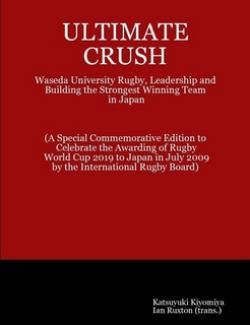Ultimate Crush: Waseda University Rugby, Leadership and Building the Strongest Winning Team in Japan

North Carolina: Lulu Press, 2006, 150 pages
Review by Ian Nish
This book was inspired by the death of Katsuhiko Oku (1958-2003) who will be known to many readers as the former Counsellor of the Japanese Embassy in London with special responsibility for the Japan Information and Cultural Section. Subsequently he was gunned down in an ambush during duty in Iraq and was given the posthumous title of Japanese ambassador to that country. His connection with this book is that he was an Old Boy of Waseda Rugby Club for which he had played and with which he kept close ties. The author of this book set up in his honour a Non-Profit Organization, the Oku-Inoue Fund for the children of Iraq, just as rugby-playing associates in London set up a similar fund in his name. The name of Oku was thus commemorated along with that of his colleague Masamori Inoue with whom he died.
This is a rugby autobiography written by Katsuyuki Kiyomiya (1967- ), rugby player and coach of Waseda University team for five years from 2001 to 2006. It was originally published in Japanese as Kyukoku no shori (Ultimate Crush) [Kodansha 2006] and contains not just an account of his Waseda career but also his theories on rugby tactics. Professor Ian Ruxton of Kyushu Institute of Technology, himself an enthusiast for Japanese rugby, offered to translate the volume because he felt that “one of the reasons why the Japan Rugby Football Union unfortunately failed in its bid to bring the Rugby World Cup 2011 to this country was the lack of knowledge of Japanese rugby throughout the world.” (page iii) His translation captures well the conversational style of rugby talk and, combined with his extended introduction, is an enlightening read.
Kiyomiya, a former captain of Waseda, was nominated as coach when he retired from playing. But he met resistance from the players because he was a forward and they wanted a back. He was eventually accepted and his coaching methods proved to be successful in his first season and took the side out of a long period of poor performances. At the end of his first year, the team was thought to be fit to tour the UK as part of the “Anglo-Japanese cultural exchanges” which Counsellor Oku was organising. But the team needed a slogan, characteristically in the English language. Counsellor Oku put up many suggestions and “Ultimate Crush” eventually met with approval from the team. (Hence the title of this book.) Its exact implications are vague; but clearly opponents were well advised to take cover.
Whatever the mystic properties of the slogan, Kiyomiya restored the fortunes of the Waseda team, which was successful in the Kanto Universities League, beating their arch-rival Kanto Gakuin in the University Championships in January 2005. They also played well in the All-Japan Championship matches and against visiting teams from Oxford and Cambridge. There were ups and downs of fortune; but broadly he accomplished great things.
Yet despite the positive message of this book in favour of rugby, there is at the end a note of disappointment about the present state of Japanese rugby. He writes
“This is because the number of students and high school pupils playing the game is decreasing…When I was a player, rugby was very popular. High school rugby was broadcast nationwide on television, and Hanazono Rugby stadium was packed day after day. But now there is not even a pale shadow of that.” (page 142)
Kiyomiya is an evangelist for rugby and seeks by this and other books to restore the popularity of the sport in Japan and its international image.

